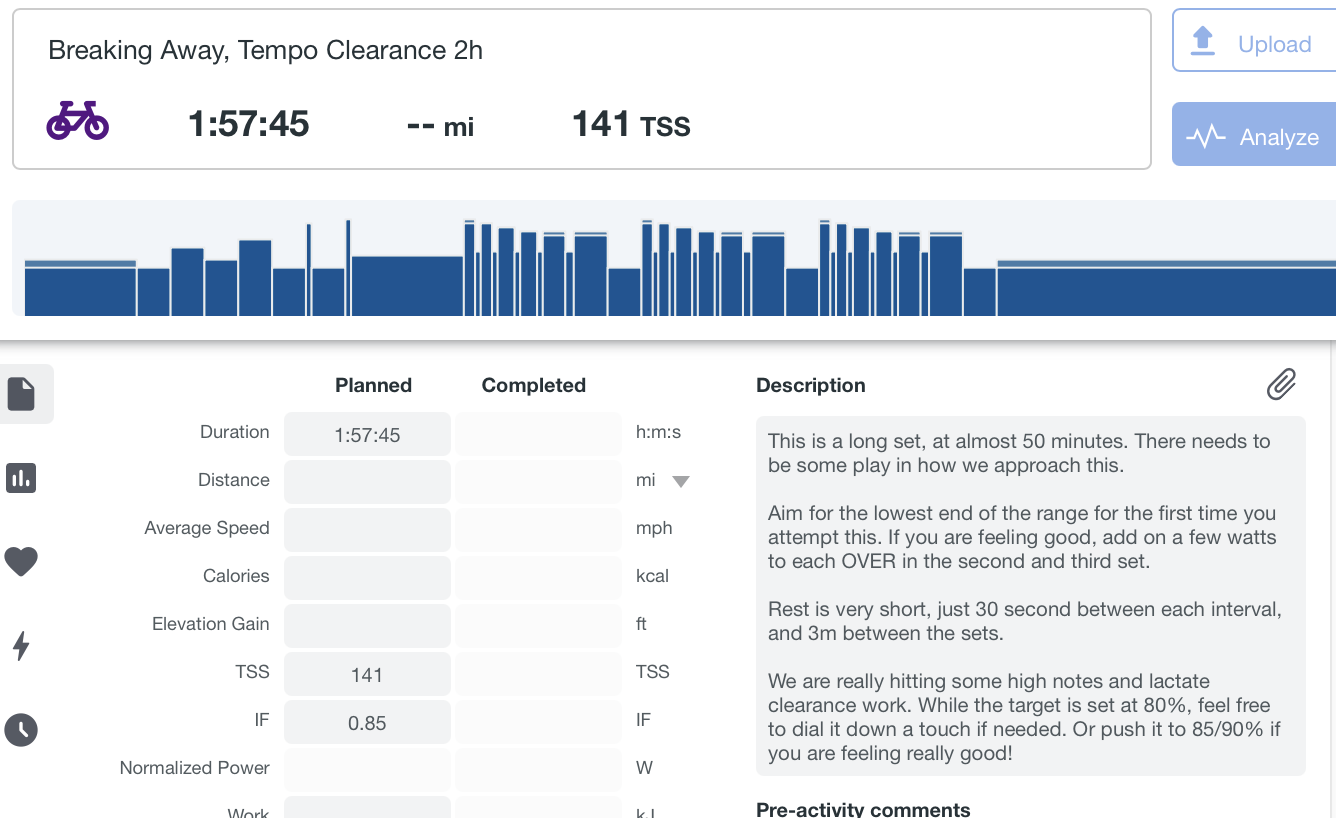Neuromuscular Training: Improve Race Performance
Improve Race Performances with Specific High Intensity Training
TLDR: What should you expect to get from this training musing? The problem lies in how we traditionally view training zones. For years, I've used classic training zones to guide athletes, distinguishing between threshold, VO2 max, and anaerobic capacity. But here's where it gets interesting: traditional training software typically lumps all efforts above 120% of FTP into one "anaerobic" category. This oversimplification is doing athletes a serious disservice.
We all know how hard road racing is, and how hard you need to train in the build phase before a big race. But I hadn’t put too much thought into basic zone configurations, which can make training ride data seem really hard, when it might not actually be.
I have a lot of examples here that may seem a bit exhaustive (as in “okay we get it, we gotta SMASH above 150% FTP), but wanted to paint the picture from a lot of road races, crits, and workouts. I wasn’t trying to beat a dead horse.
This musing all started back in 2023 when I was going to be heading north for Capital Region Road Race, an absolutely brutal course just outside the state capital of Albany.
I was looking up power data of the race because in 2023 I was getting shellacked early—I had decided that I wasn’t going to race that year for a bunch of life reasons, but then pivoted when I missed it a TON and dove back in. Well, I wasn’t race fit and just got destroyed at Amateur Road Nats and had to come back to the drawing board.
Another thought in the back of my mind was taking me back to the first time I did this race in 2012—I was pulled and placed as I went wayyyyy too hard up the first climb and was counterattacked and literally lost the group on the second climb. Or soon thereafter—it was a whirlwind that I rather forget the details of.
Neuromuscular Smashing
Fast Forward to 2023 and I looked up either Kyle Murphy or Robin Carpenter’s race file as I knew they went 1-2. I dug up this old image and all we need to know is that: THERE WAS A TON OF “NEUROMUSCULAR” SMASHING”....
Here’s what shook out in 2023:
Now you might be thinking “Strava zones? For real?” I’m good with six zones.
Zone 6 - Misleading
I've realized it is for me to split the classic "Zone 6: Anaerobic" into at least two buckets like WKO does, which basically shakes out to 120-150% FTP, and 150-235ish% (I’m not as concerned with the upper limit).
When using only 6 zones for training, I can take a 30/15 workout and think "wow, 19m of anaerobic time"...on paper, impressive—but when using iLevels (9 zones), that same workout clearly had NO time over 140% FTP, which i find very important to note for racing purposes...there's a LOT of smashing above that in races, especially those decisive moments where races are won and lost. While I hit some "anaerobic training" at 19 whole minutes, it still lacked those 30-90 second banger efforts. I fooled myself!
See below, same workout obviously. The top is 9 zones, and the bottom is 6…”anaerobic” is ANYTHING at 120%+, but there is a BIG difference between 130% and 180%!!!!
No time at FRC in the 9 zone model which is different for every athlete, but roughly 150 to 235-250% FTP (I’m not as concerned with the upper level here for this analysis).
So how are your zones set? Most likely if you are using Strava, they have 120-150% as Anaerobic and 150%+ as Neuromuscular. Bravo.
Most TrainingPeaks zones are only 6. I think this is a HUGE limiter.
How Much Neuromuscular Time in Zone?
So I wanted to dig into the numbers a bit more.
First, WKO has recommended ranges for training at certain zones, called Optimized Intervals.
Optimized Intervals puts TiZ for true FRC/Anaerobic workout, 4-12m
4-12 min is obviously a HUGE range when we consider how hard the effort is going to be (150% FTP and above). 4 x 1m or 12 x 1m…2 totally different days.
TLDR: start small and build up.
BUT, how does this shake out with real world racing? Do we actually need this?
Actual FRC Time in Zone from Races
The short answer: YES….
Time in Zone above 150% from some races that I had done where I knew there was a TON of smashing…
2024 Tiger Town (Clemson) Road Race: 10min (7th place)
2023 Capital Region Road Race: 9m (7th)
2023 Amateur nationals: 7m, dropped (so would have been more!)
2019 Gravel worlds: 17m
2023 Hampton double crit day 9.5, (1.5m above 900!)
2023 Gravel Grinder Nats 8m
Capital Region as laid out by different Analysis platforms or zones…
Winston Salem Crit: tons of hard work in 1 hour!
Many times a crit has a LOT of this smashing, which is always a great neuromuscular tune up.
Take note that this is from only 1H, whereas in road races above we were looking at files of 3H or more.
Exceptions to this Observation?
Now to be fair, there are other races that I’ve been in the break and are way more VO2 time than pure smashing.
Carter County: only 2.5m FRC but 51m @ VO2 and 89 min at Threshold. (Zones below do not match up perfectly because Strava was set at 405 FTP and WKO mFTP at 395, and FTP/FRC starts at 410w, so things got a bit muddy there)....Strava pick this up as more tempo, WKO as more FTP/VO2….)
Every race is different and to be well rounded, we need to be good at many things!
FRC Time in Zone during Workouts
I’ve gone for KOM’s and had “9m” anaerobic but in reality it was less than 2.5m of the really hard stuff (top image). Deceivingly, it looks almost 9m anaerobic (bottom).
Breaking Away VO2 Max workout
Ah I love this style of long VO2 work…I have a few variations—descending duration, or increasing, like this one.
One might think it’s that saucy super smashing, but it’s not.
July 1, 2023 Ride BANGERS
This one sort of splits the middle. We can see this as a win or a HUGE MEGA WIN. 7.5 minutes (FRC + FRC/PAX) vs 17 minutes is a totally different story!
Climbing Hills for Gran Fondo Training
This one is NO DOUBT a mega banger day, but just make sure we see the difference in FTP/VO2 work and Anaerobic/Neuromuscular work.
Learn about our Gran Fondo Cycling Training Plan here
Conclusion
The consequences of inadequate high-intensity training become painfully apparent in races. Those muscle cramps you experience two and a half hours into a gravel race? They're often not about endurance – they're your muscles telling you they weren't prepared for repeated maximum efforts at race intensity.
As we head into 2025, I’ve challenged myself to continue to rethink approaches to hard training for my athletes, but also helping them see that no amount of training can perfectly replicate the unique demands of actual races.
While "going hard" is important, we need to be more precise about what "hard" really means. In the world of bike racing, it's not enough to just accumulate time above threshold – you need to push into those extremely challenging zones that make you question your life choices. That's where race-winning fitness is built, and that's what separates successful racers from those who are perpetually wondering why they can't quite hang on when the pace gets savage.
Remember, the next time you're planning your high-intensity workouts, ask yourself: "Am I really going hard enough?" Because in racing, there's no such thing as too prepared for the pain cave.



























